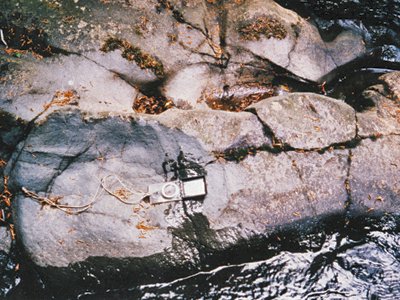Earth Science Conservation Review
| Glenmornan River, Artigarvan | Tyrone |
| Site Type: | Stream section |
| Site Status: | ESCR |
| Grid Reference: | C382008 |
| Google maps: | 54.85395,-7.40522 |
| Rocks | |
|---|---|
| Rock Age: | Precambrian (Dalradian) |
| Rock Name: | Argyll Group, Dungiven Formation, Tayvallich Subgroup |
| Rock Type: | Lava, Phyllite, Pillow lava, Schist |
| Interest | |
Summary of site:
The importance of this site lies in the recognition of pillow lavas in the ancient and highly altered (metamorphosed) rocks of the Dalradian Supergroup.
The rock section is exposed in the bed and banks of the Glenmornan River, just upstream from the bridge in the middle of Artigarvan. The highest and youngest beds are seen about 250m upstream, where they consist of schists and phyllites separated by horizons of thin grey and dark blue crystalline limestones. Pillow lavas can be seen 125m downstream.
Pillow lavas are formed from molten rock with the composition of basalt which flows from open fractures into water, most commonly on to the sea bed. As the lava is extruded into the water, the outer surface chills, forming a plastic carapace which is inflated by more lava until it achieves a fully rounded form and detaches. The optimum size for these pillow-like structures is about 1m in diameter and they are often found in stacks on the sea bed around the feeder fissures. They can be hundreds of metres thick. The detached pillows, still slightly plastic, settle on to the stack and accommodate their shape to those beneath. Common features of lava pillows include: chilled, glassy or fine-grained margins; radiating and sometimes concentric cooling cracks; and hollow centres. Some of these phenomena can be seen here.
This combination of rock types suggests that this section is part of the Dungiven Formation, the earliest Dalradian rocks to be seen in Northern Ireland. They were formed on a shallow sea bed (indicated by the limestones and sandy beds), over 600 million years ago, at a time of powerful structural tension as the Gondwana supercontinent split along a line of diverging convection currents in the rocks deep below the crust. This caused the crust to thin and, in places, led to volcanism as molten rock exploited the weaknesses and broke through.
The rocks were metamorphosed much later when a continental collision forced them deep below their neighbouring continental plate, around 465 million years ago.
These are some of the earliest pillow lavas seen in Northern Ireland and consequently they are important and worthy of protection. The exposures were previously much more extensive but some have been lost to dumping and development along the river bank and one of the best pillow lava sites appears to have surrendered to bridge strengthening works. Care should be taken to ensure that nothing further is obscured.
The rock section is exposed in the bed and banks of the Glenmornan River, just upstream from the bridge in the middle of Artigarvan. The highest and youngest beds are seen about 250m upstream, where they consist of schists and phyllites separated by horizons of thin grey and dark blue crystalline limestones. Pillow lavas can be seen 125m downstream.
Pillow lavas are formed from molten rock with the composition of basalt which flows from open fractures into water, most commonly on to the sea bed. As the lava is extruded into the water, the outer surface chills, forming a plastic carapace which is inflated by more lava until it achieves a fully rounded form and detaches. The optimum size for these pillow-like structures is about 1m in diameter and they are often found in stacks on the sea bed around the feeder fissures. They can be hundreds of metres thick. The detached pillows, still slightly plastic, settle on to the stack and accommodate their shape to those beneath. Common features of lava pillows include: chilled, glassy or fine-grained margins; radiating and sometimes concentric cooling cracks; and hollow centres. Some of these phenomena can be seen here.
This combination of rock types suggests that this section is part of the Dungiven Formation, the earliest Dalradian rocks to be seen in Northern Ireland. They were formed on a shallow sea bed (indicated by the limestones and sandy beds), over 600 million years ago, at a time of powerful structural tension as the Gondwana supercontinent split along a line of diverging convection currents in the rocks deep below the crust. This caused the crust to thin and, in places, led to volcanism as molten rock exploited the weaknesses and broke through.
The rocks were metamorphosed much later when a continental collision forced them deep below their neighbouring continental plate, around 465 million years ago.
These are some of the earliest pillow lavas seen in Northern Ireland and consequently they are important and worthy of protection. The exposures were previously much more extensive but some have been lost to dumping and development along the river bank and one of the best pillow lava sites appears to have surrendered to bridge strengthening works. Care should be taken to ensure that nothing further is obscured.
| Enlander, I., Dempster, M. & Doughty, P., 2025. Glenmornan River, Artigarvan, County Tyrone, site summary. [In] Earth Science Conservation Review. https://www.habitas.org.uk/escr/summary.php?item=145. Accessed on 2025-04-03 |
| Previous Site | Next Site |

